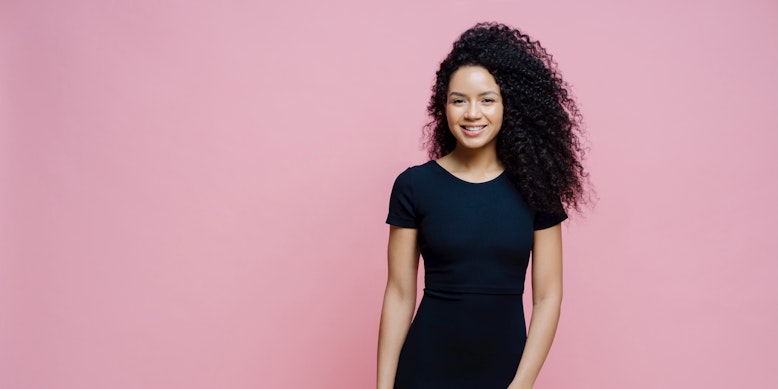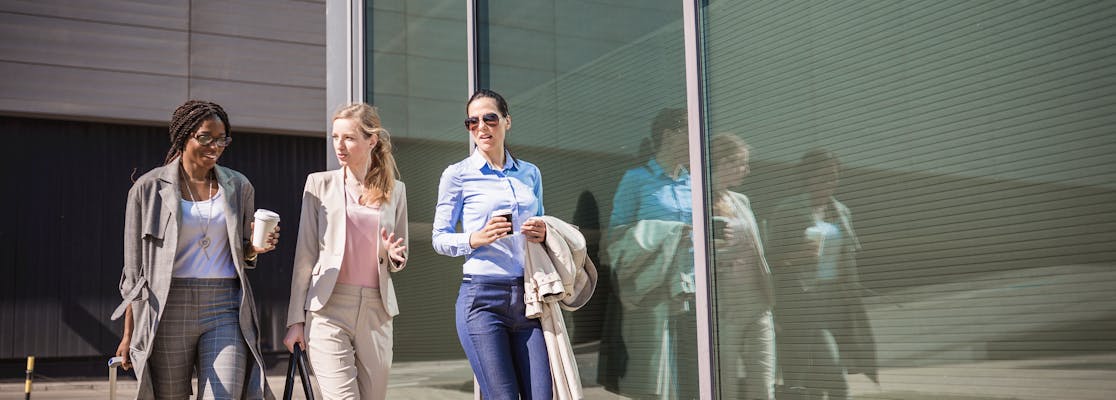What Is Business Casual for Women?
Updated November 20, 2023
- What Is a Business Women’s Outfit?
- Advantages of Adhering to a Dress Code
empty
empty
empty
empty
empty
empty
empty
empty
empty
empty
empty
empty
- Typical Business Women's Outfit Options
empty
empty
empty
empty
empty
empty
empty
empty
- What Is Not Included in a Business Women Outfit?
empty
empty
empty
empty
empty
empty
- When Should Business Women's Outfits be Worn?
empty
empty
empty
empty
empty
empty
empty
- Frequently Asked Questions
- Final Thoughts
With the changing trends in the workplace, knowing what to wear to the office can be a challenge. Especially when terms like ‘business-casual’ offer lots of gray areas.
This article aims to clarify what outfit options are available and when business casual attire for women is appropriate.
What Is a Business Women’s Outfit?
A business women's outfit refers to clothing suitable for a professional (work) environment.
The specific dress code can vary depending on the industry, company culture, and individual preferences.
Some companies have a more formal dress code, while others may adopt business casual dress codes. There may also be instances where dress codes are more of an unspoken rule rather than company policy.
Adhering to the dress code and dressing professionally can help make a positive impression in a business setting.
However, having confidence and being comfortable while wearing your clothes is also an important aspect of your overall professional image.
While finding clothes and outfits that suit you and the occasion can be challenging, there are several different women's business professional attire looks that can be worn in the office.
Advantages of Adhering to a Dress Code
Adhering to a business women’s outfit dress code, especially in a professional or corporate environment, offers several advantages:
Professionalism
Dress codes help establish a professional atmosphere within the workplace. When employees dress in a manner that aligns with the company's standards, it conveys a sense of seriousness and commitment to the job.
Consistency
A dress code ensures a consistent and uniform appearance among employees. This uniformity can create a cohesive and team-oriented work environment, regardless of whether you are asked to dress in business casual or more formally.
Client and Customer Perception
A well-dressed workforce can positively influence how clients, customers, and business partners perceive the company. It can help build trust and confidence in the organization's capabilities.
Branding
Dress codes can be a part of a company's branding efforts. Uniforms or specific attire can reinforce the company's image and values.
For example, a tech startup may adopt a business casual dress code to reflect its innovative and relaxed culture, while a law firm may choose formal attire to convey professionalism and authority.
Safety
In certain industries, dress codes are essential for safety reasons. Employees may be required to wear specific clothing or protective gear to minimize workplace hazards.
For example, in some countries, hairstylists must wear closed shoes to prevent any injuries to their feet should they drop their scissors.
Productivity
Having a dress code can save time and energy for both employees and management. Employees don't have to spend an excessive amount of time deciding what to wear each day, and managers don't need to address inappropriate attire issues or complaints as frequently.
Respect for the Workplace
Adhering to a dress code demonstrates respect for the workplace and its rules. It can create a sense of order and discipline, which can positively impact overall workplace culture.
Reduced Distractions
A dress code can help minimize distractions in the workplace. When everyone is dressed appropriately, there's less potential for disruptions or discomfort caused by those viewing an outfit as provocative or overly casual.
Equality
A well-defined dress code can promote equality among employees. It ensures that no one is singled out or unfairly judged based on their clothing choices, socio-economic status, or personal style.
Compliance With Regulations
In some industries, adherence to specific dress codes is required to comply with legal or regulatory standards.
For example, healthcare professionals often have strict dress codes to maintain hygiene and patient safety.
Improved Employee Confidence
Knowing what to wear and feeling appropriately dressed can boost employees' confidence. When employees feel confident in their appearance, they may perform better and interact more effectively with colleagues and clients.
Professional Development
Encouraging employees to dress professionally can be seen as an investment in their professional development. It can help them develop good grooming and presentation skills, which can be valuable in their careers.
Typical Business Women's Outfit Options
Business women often have a variety of outfit options to choose from to suit different workplace dress codes, seasons, and personal preferences.
Here are some typical formal and casual business women outfit options.
Traditional Suit
A classic suit is considered more formal than casual. Suits typically consist of a blazer and matching trousers or a skirt. It is a timeless look.
Opt for neutral colors like black, navy, gray, or charcoal for a professional look.
Pair it with a blouse or button-up shirt.
Pantsuit
A pantsuit is a versatile alternative to a traditional suit. It offers comfort and ease of movement.
This outfit was made popular by trousers such as the YSL Le Smoking tuxedo suit. It is also a great option for business casual attire for women and can be worn in almost every season.
Choose a well-tailored pantsuit with a coordinating blouse or top. Finish the outfit off with a pair of loafers or stilettos.
Skirt Suit
A skirt suit features a blazer paired with a matching skirt.
Ensure the skirt length is modest and falls at or below the knee for a professional appearance.
Depending on the season, you have so many options with this outfit. You can pair your skirt with thick black stockings or more fashion options, if appropriate.
As for skirt options, there are several options and certainly some that will suit your body shape, including:
- A-line
- Pencil
- Pleated
- Wrap-around
- Balloon
- Yoke

Dresses
Dresses are a convenient choice for business attire, as it is only one piece of clothing that can often be styled in several ways with belts, shoes, and outerwear.
A business casual dress for women can include:
- Tailored shift dresses
- Wrap dresses
- Sheath dresses
Ensure they have modest necklines and hemlines.
Layer with a blazer or cardigan for added professionalism (great option for a winter business women casual look) or wear with sandals for summer business women casual looks.
Tunic and Leggings
In some creative or business casual workplaces, a longer tunic top paired with well-fitted leggings and stylish flats can be appropriate.
It provides a lot of comfort and moveability while still looking stylish. It’s also another summer business women casual look you can add to your wardrobe.
Top and Bottoms
This outfit follows the same formula as a skirt or pantsuit but is more casual.
Instead of a blazer, jacket, shirt or blouse, you can pair your skirt/trousers with a plain T-shirt.
This business women casual top is a great addition to your closet and can be dressed up with heels or dressed down with tennis shoes. It can work as a summer, spring, autumn or winter business women casual look.
Accessories
Complete your outfit with minimalistic jewelry, such as stud earrings and a simple necklace.
A professional-looking watch and a structured handbag or briefcase can add sophistication.
It is important to note that what is considered appropriate will differ depending on the dress code policy and the place where you work. Those organisations that are more style and fashion-focused will have more lenient rules but will expect you to dress the part.
Footwear
Closed-toe pumps, loafers, or ankle boots in neutral colors are standard choices for formal business attire.
However, business casual shoes for women might include popular tennis shoes like Converse.
Regardless of the footwear you choose, ensure they are comfortable for long hours at work.
What Is Not Included in a Business Women Outfit?
When choosing clothes for work, there are some clothing items and styles that are considered too casual, informal, or inappropriate for the work environment.
These include the following items and styles.
Casual Jeans
Jeans, especially those with a distressed or overly casual appearance, are generally not considered appropriate in most professional settings. Save them for casual Fridays or dress-down days if your workplace allows.
Very smart, dark colored jeans might be exceptable for a business casual outfit, especially when paired with a smarter style top.
Shorts
Shorts, even dressy or tailored ones, are typically not appropriate in a business setting, unless you work in a very casual or creative environment.
Crop Tops
Crop tops that expose the midriff are typically not suitable for a professional environment.
Sweatpants or Athletic Wear
Unless you work for a relaxed company, sweatpants, yoga pants, and athletic wear are too casual for the workplace. They are designed for comfort and physical activity, not a professional appearance.
Mini Skirts
Extremely short skirts or dresses that are well above the knee may be considered too revealing for many workplaces.
Ripped or Distressed Clothing
Clothing items with large rips, tears, or excessive distressing are too casual for business attire.
However, it's important to remember that dress codes can vary widely and workplace trends are always evolving.
Always check with your employer or HR department for guidance on the dress code in your workplace to ensure you're adhering to the appropriate standards.
When Should Business Women's Outfits be Worn?
Business women's outfits should be worn in professional or business settings, typically during formal or business-related activities.
Here are some common occasions and situations where businesswomen's attire is appropriate.
Business Meetings
When attending meetings with clients, colleagues, or superiors, it's essential to dress professionally to make a positive impression and convey seriousness and competence.
Job Interviews
When interviewing for a job or participating in a job interview process, dressing in business attire is crucial to demonstrate your professionalism and suitability for the role.
Conferences and Seminars
Attending conferences, seminars, workshops, or industry events often requires business attire, especially if networking or representing your organization. Depending on the nature of the conference, business casual clothes for women might be more appropriate and comfortable.
Client Meetings
When meeting with clients or customers, it's important to dress professionally to build trust and credibility.
Professional Associations
If you are a member of a professional association or organization, its events and meetings may require business attire.
Court Appearances
In legal professions, court appearances necessitate formal and professional attire.
Client Pitches
When making sales pitches or presentations to potential clients, it's crucial to dress professionally to instill confidence in your offerings.
Frequently Asked Questions
Business casual for women generally implies attire that is polished yet somewhat relaxed. Typically, this includes slacks or khakis, blouses, skirts, and dresses with modest hemlines. Denim can be appropriate if it's neat and paired with more formal items like a blazer.
Women dressing business casual should aim for a neat, polished appearance. Pair tailored pants or skirts with coordinated blouses or knit tops. A blazer can elevate the look. Avoid overly casual or flashy attire, opting for modest, professional pieces, and sensible shoes.
Business casual clothes for women are available at various retailers like Banana Republic, Ann Taylor, Gap, and Nordstrom. These stores offer a range of options suitable for different professional settings. Online platforms like ASOS and Zappos also provide diverse selections catering to varied budgets and styles.
Business casual shoes for women include flats, loafers, or low heels, typically in neutral colors. They should be clean, polished, and in good condition. Comfort is crucial, especially for those who spend a lot of time on their feet. Avoid overly flashy or casual styles.
Business casual for women is characterized by a neat, professional appearance. It includes tailored pants, skirts, blouses, and dresses. The attire is less formal than traditional business wear but more polished than casual weekend wear. Neutral tones are common, and accessories are typically understated.
Jeans can be acceptable in a business casual setting if they are clean, well-fitted, and free from rips or excessive fading. Dark-wash jeans are usually more suitable. Pair them with more formal items like a blazer and closed-toe shoes to maintain a professional appearance. However, always consider the company's specific dress code, as some may not allow denim.
Open-toed shoes can be appropriate for business casual environments, but it largely depends on the company's dress code. If they are permitted, they should be polished and professional, like peep-toe flats or heeled sandals, and the feet should be well-groomed.
Sleeveless tops or dresses can be acceptable in business casual settings, but they should maintain a sense of professionalism. Ensure that the neckline is modest and the overall fit is appropriate. In more conservative settings, consider pairing with a cardigan or blazer.
While traditional sneakers are usually too casual, clean, well-maintained fashion sneakers in neutral colors may be acceptable in more relaxed business casual environments. It is crucial to adhere to individual workplace policies and pair them with more polished pieces to maintain professionalism.
Accessorize business casual attire with understated and polished items. A classic watch, simple jewelry, and leather belts are suitable options. Avoid overly flashy accessories. Opt for neutral or subdued color palettes to maintain a professional appearance.
There are typically no strict color restrictions for business casual, but it’s wise to stick to a relatively subdued and neutral color palette, especially in conservative environments. Avoid overly bright or neon colors. Earth tones, pastels, and jewel tones can be appropriate.
Shorts are generally considered too casual for most business casual environments. However, some creative or relaxed workplaces may permit tailored, knee-length shorts. Always refer to the company’s specific dress code and opt for a more conservative approach when in doubt.
Final Thoughts
Remember to consider your workplace's dress code and culture when selecting your outfit.
Some workplaces may have a formal dress code, while others may allow for more flexibility with business casual clothes for women or smart casual attire. There are many business casual outfits for women to choose from.
Adhering to the dress code while expressing your personal style can help you feel confident and professional at work.



